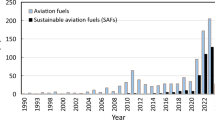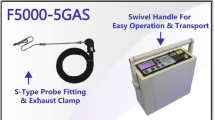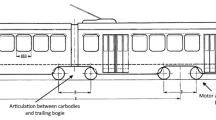Abstract
An objective evaluation scheme for automotive technical and comprehensive performance could provide critical and instructive insights for academic research, engineering practice, and commercial marketing of vehicles. In this paper, the technical performance index \(A = S/\left( {T_{1} \cdot T_{2} } \right){ }\) \(({\text{m}}/({\text{s}}^{2} \cdot \;{\text{L}}))\) and comprehensive performance index \(F = M \cdot S/\left( {T_{1} \cdot T_{2} } \right),\) (\({\text{kN}}\cdot\;{\text{L}}^{ - 1}\), where \(M\) is the vehicle mass) are formulated by incorporating the vehicle 0–100 \( {\text{km}}\cdot\;{\text{h}}^{ - 1}\) acceleration duration \({ }T_{1}\), 100–0 \( {\text{km}}\cdot\;{\text{h}}^{ - 1}\) braking duration \({ }T_{2}\), and fuel economy \(S\) (mileage per liter fuel at constant speed) to assess the vehicle’s longitudinal dynamic performance. \(A\) and \(F\) offer a clear physical implication of a vehicle’s acceleration capability and traction efficiency acquired per unit of fuel consumption, respectively. These indexes are used for wide case studies of popular market sedans and SUVs of joint ventures (JVs) and domestic brands in China over the last 17 years. The findings prove that this approach could be effectively and reliably utilized for the objective evaluation and analysis of the technical and comprehensive performance of automotive models.







Similar content being viewed by others
References
Zhao, F., Liu, Z., Hao, H., Wang, Y., Zhao, S.: A comprehensive evaluation system for automotive industry of different nations. Chinese J. Eng. Des. 6(2), 79–86 (2016). https://doi.org/10.3969/j.issn.2095-1469.2016.02.01
Liu, D., Wang, T., Gao, Y., Li, H.: Research on the e-valuation method of vehicle performance. Mech. Sci. Technol. 31(03), 379–383 (2012). https://doi.org/10.13433/j.cnki.1003-8728.2012.03.034
Huang, W., Wen, D., Geng, J., Zheng, N.: Task-specific performance evaluation of UGVs: Case studies at the IVFC. IEEE trans. Intell. Transp. Syst. 15(5), 1969–1979 (2014). https://doi.org/10.1109/TITS.2014.2308540
Zhao, F., Liu, Z.: Strategic judgment on building a strong automotive industry in China. Chinese J. Eng. Des. 4(05), 313–318 (2014). https://doi.org/10.3969/j.issn.2095-1469.2014.05.01
Zhong, Z., Qiao, Y., Wang, J., et al.: Summary of strategy research on automobile power in new era(I). SS-CAE. 20(01), 1–10 (2018). https://doi.org/10.15302/J-SSCAE-2018.01.001
Creutzig, F., Papson, A., Schipper, L., Kammen, D.M.: Economic and environmental evaluation of compressed-air cars. Environ. Res. Lett. (2009). https://doi.org/10.1088/1748-9326/4/4/044011
Zhang, X., Ding, C., Zhang, T.: A hierarchical model for automotive PEM fuel cell system comprehensive evaluation and comparison. Int. J. Hydrog. Energy 39(3), 1476–1484 (2014). https://doi.org/10.1016/j.ijhydene.2013.10.172
Jiang, K., Luo, Z., Feng, Z., Huang, Z., Yu, Z.: Subjective evaluation of automobile power performance based on RA-AHP. Cogn. Technol. Work 20, 413–424 (2018). https://doi.org/10.1007/s10111-018-0488-9
Zhu, J., Khajepour, A., Esmailzadeh, E., Kasaiezadeh, A.: Ride quality evaluation of a vehicle with a planar suspension system. Veh. Syst. Dyn. 50(3), 395–413 (2012). https://doi.org/10.1080/00423114.2011.592591
Wang, B., Guan, H., Lu, P., Zhan, J.: Novel evaluation method of vehicle suspension performance based on concept of wheel turn center. Chin. J. Mech. Eng. 28(5), 935–944 (2015). https://doi.org/10.3901/CJME.2015.0724.101
Damien, S.C.: Reducing informational asymmetry impacts choices and improves safety: An evaluation of automobile crash tests. J. Risk Insur. 89, 697–723 (2022). https://doi.org/10.1111/jori.12375
Sohrabi, S., Khodadadi, A., Mousavi, S.M., Dadashova, B., Lord, D.: Quantifying the automated vehicle safety performance: a scoping review of the literature, evaluation of methods, and directions for future research. Accid. Anal. Prev. (2021). https://doi.org/10.1016/j.aap.2021.106003
Kim, D., Lee, S., Lee, H., Choi, I., Shin, J., Park, K.: Development of quantitative methods for evaluating failure safety of Level 3 autonomous vehicles. J. Korea Inst. Intell. Transp. Syst. 18, 91–102 (2019). https://doi.org/10.12815/kits.2019.18.1.91
Chen, S., Shi, T., Wang, D., Chen, J.: Multi-objective optimization of the vehicle ride comfort based on kriging approximate model and NSGA-II. J. Mech. Sci. Technol. 29(3), 1007–1018 (2015). https://doi.org/10.1007/s12206-015-0215-x
Li, S., Huang, M., Guo, M., YU, M.: Evaluation model of autonomous vehicles speed suitability based on overtaking frequency. Sens. Basel. 21(2), 371 (2021). https://doi.org/10.3390/s21020371
Kumar, A., Thakura, P.R.: Performance evaluation of hybrid electric vehicles for sustainable transport system. IJITEE. 8(11), 195–201 (2019). https://doi.org/10.35940/ijitee.K1280.0981119
Kong, F., Guo, K., Zong, C.: Study on grey relations-hip between objective and subjective evaluation of motor vehicle maneuverability and stability based on genetic algorithms. Chin. J. Mech. Eng. 40(7), 119–123 (2014). https://doi.org/10.3321/j.issn:0577-6686.2004.07.024
Zhao, J., Liu, J., Yang, L., He, P.: Exploring the relationships between subjective evaluations and objective metrics of vehicle dynamic performance. J. Adv. Transport. (2018). https://doi.org/10.1155/2018/2638474
Sun, Y., Tao, G., Xiong, G., Chen, H.: The fuzzy-AHP evaluation method for unmanned ground vehicles. Appl. Math. Inf. Sci. 7, 653–658 (2013). https://doi.org/10.12785/amis/070232
Chen, X., Zhong, J., Sha, F., Zhong, Z.: Research on innovative plug-in hybrid electric vehicle comprehensive energy consumption evaluation method based on statistic energy consumption. Sci. Prog. 104(4), (2021). https://doi.org/10.1177/00368504211050284
Song, K., Chen, H., Wen, P., et al.: A comprehensive evaluation framework to evaluate energy management strategies of fuel cell electric vehicles. Electrochim. Acta 292, 960–973 (2018). https://doi.org/10.1016/j.electacta.2018.09.166
Granovskii, M., Dincer, I., Rosen, M.A.: Economic and environmental comparison of conventional, hybrid, electric and hydrogen fuel cell vehicles. J. Power Sour. 159, 1186–1193 (2006). https://doi.org/10.1016/j.jpowsour.2005.11.086
Offer, G.J., Howey, D.A., Contestabile, M., et al.: Comparative analysis of battery electric, hydrogen fuel cell and hybrid vehicles in a future sustainable road transport system. Energ. Policy. 38(1), 24–29 (2010). https://doi.org/10.1016/j.enpol.2009.08.040
Ouyang, H., Xiao, Y., Hu, S., Tang, X., et al.: Establishment and application of comprehensive evaluation method for automobile technical performance. J. Cent. South. Univ. 51(03), 650–660 (2020). https://doi.org/10.11817/j.issn.1672-7207.2020.03.009
Das, M.C., Pandey, A., Mahato, A.K., Singh, R.K.: Comparative performance of electric vehicles using evaluation of mixed data. Opsearch 56(3), 1067–1090 (2019). https://doi.org/10.1007/s12597-019-00398-9
Yu, Y.: Technology roadmap for energy saving and new energy vehicles 2.0 leads the development of China’s automobile industry. Mod. Compon. 11, 8–10 (2020). https://doi.org/10.3969/j.issn.1672-657X.2020.11.002
Meng, F., Jin, X.: Evaluation of the development cap-ability of the new energy vehicle industry: An empirical study from China. Sustain. Basel. (2019). https://doi.org/10.3390/su11092635
Acknowledgements
The National Natural Science Foundation of China (Project Name: Transmission mechanics and performance optimization of confined granular media self-adaptive differential; No. 51475475) and the Changsha Natural Science Foundation of China (Project Name: Structure principle and performance prediction of the intelligent tire; No. kq2014130) have provided funding for this research.
Author information
Authors and Affiliations
Corresponding author
Rights and permissions
Springer Nature or its licensor (e.g. a society or other partner) holds exclusive rights to this article under a publishing agreement with the author(s) or other rightsholder(s); author self-archiving of the accepted manuscript version of this article is solely governed by the terms of such publishing agreement and applicable law.
About this article
Cite this article
Liu, M., Ouyang, X., Lu, R. et al. An Evaluation Method for Automotive Technical and Comprehensive Performance. Automot. Innov. 6, 231–243 (2023). https://doi.org/10.1007/s42154-022-00213-0
Received:
Accepted:
Published:
Issue Date:
DOI: https://doi.org/10.1007/s42154-022-00213-0




